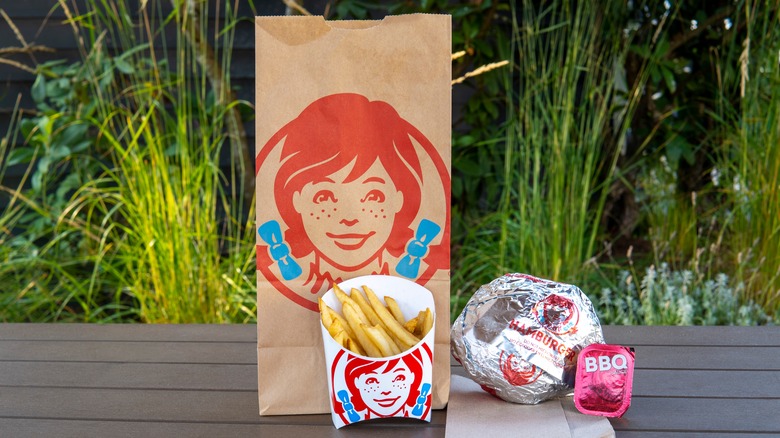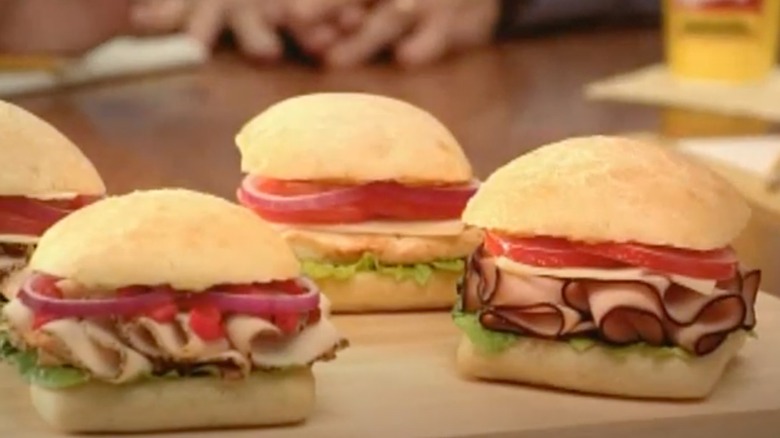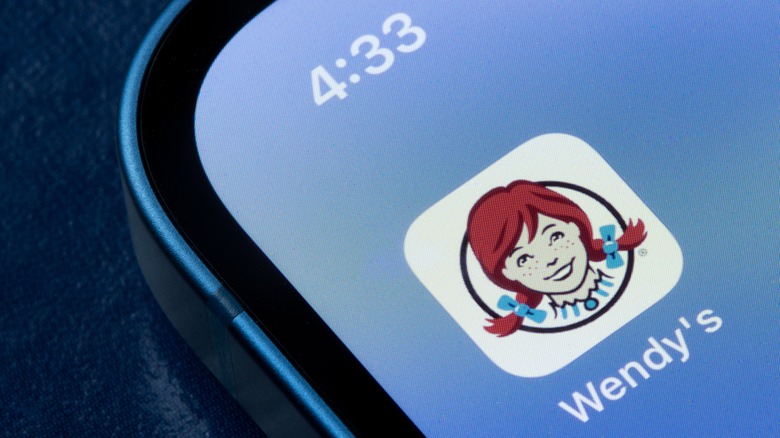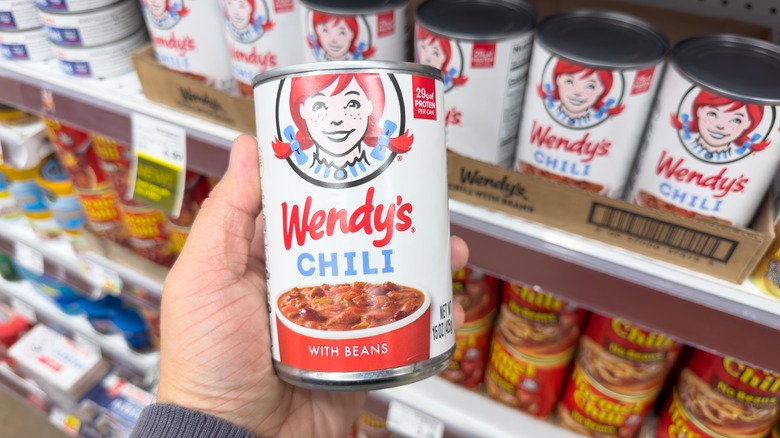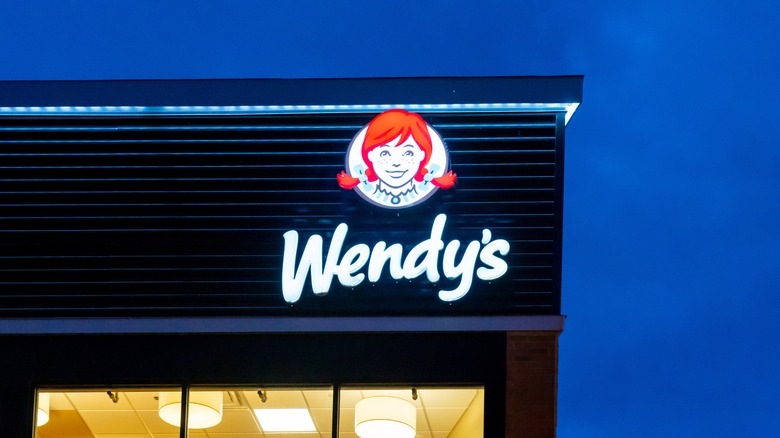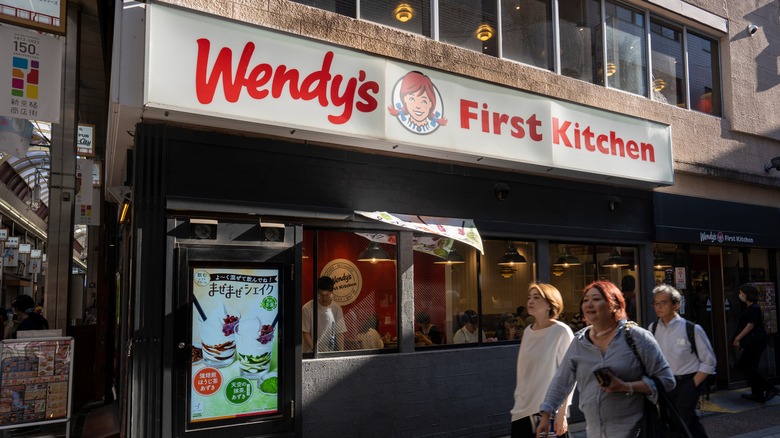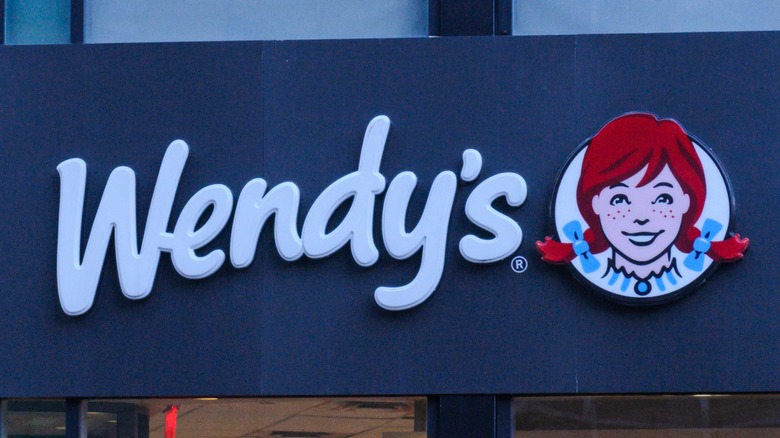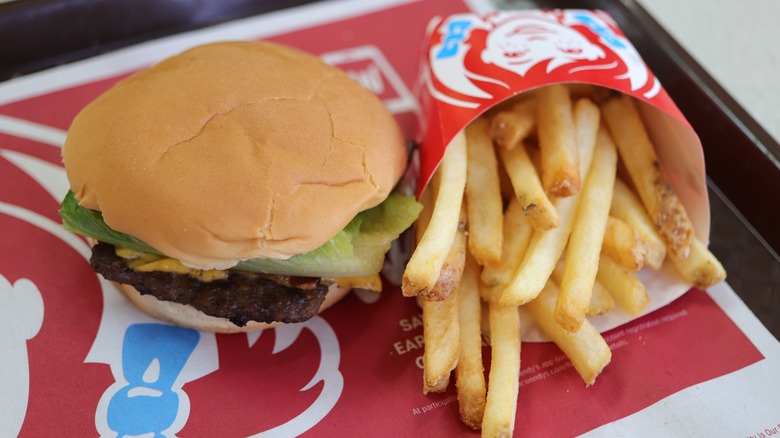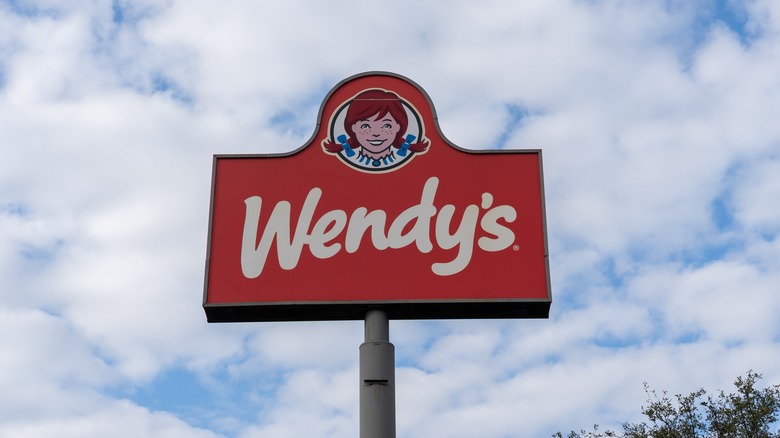12 Of The Biggest Mistakes Wendy's Ever Made
Some of the most iconic brands out there have had a few major missteps during their journeys — and Wendy's is no different. Since opening in 1969 with an initial menu of just five savory items, Wendy's has managed to grow exponentially, and today it boasts over 6,000 restaurants across the United States and approximately 7,166 locations worldwide. It's arguable, though, that in its relentless pursuit of market dominance, the brand has missed some of the finer details along the way, and it boasts some serious mistakes to show for it.
A few of these mistakes have occurred thanks to Wendy's trying to reinvigorate its restaurants, which caused it to fall flat on its face. Things like introducing made-to-order breakfasts and getting rid of its beloved SuperBar didn't just go down poorly with customers, but cost the chain a lot of money. In other moments, Wendy's has had a curiously tone-deaf approach to business crises and social media practices, and certain marketing choices have left both its customers and its backers pretty unhappy. As for those worldwide locations? They weren't all smooth sailing either, and in certain countries, Wendy's has had to perform an embarrassing retreat due to misjudging the market or just not keeping a handle on its restaurants.
1. In the 1980s, Wendy's debuted made-to-order breakfasts — and quickly got rid of them
A lot of people head to Wendy's to grab their breakfast, but the chain didn't always specialize in providing morning meals. In fact, its first attempt at introducing them went horrifically wrong. Wendy's first started serving breakfast in its restaurants in 1985, and the fanfare around them was huge, with a mass-scale marketing campaign promoting its newest menu venture. The thing that would set Wendy's apart from other restaurants was that, like its burgers, its breakfast items would be made-to-order.
This was a noble idea that didn't stick the landing whatsoever. The issue? The made-to-order format. "We made every omelet to order ... Omelets are more complicated," explained founder R. David Thomas to the Los Angeles Times. "Our competitors make things up and put them under a heat lamp ... We just couldn't compete with that. It was a brand-new procedure." Thomas conceded that ultimately the restaurant had made a mistake and that the business should have been more rigorous with its testing process before rolling these made-to-order items out. Just under a year after breakfast was introduced in its restaurants, the vast majority of businesses had removed the items from menus.
2. Wendy's removal of its SuperBar saw a lot of faithful customers unhappy
If you were a Wendy's patron at any point between the late '80s and late '90s, you might remember the SuperBar. This innovation took the salad bar (which Wendy's would ultimately get rid of) and amped it up to the next level. The SuperBar was a three-part buffet station that allowed diners to serve themselves a large number of items. As well as salad, the SuperBar had an assortment of Mexican food items, a pasta station, and a variety of sweet items, including pudding and fruits. You got all of this for just a few bucks a pop. God, we miss the 20th century, man.
Given the massive selection of food on offer and the low prices, it's little wonder that the SuperBar was a hit with customers. So it was one of the biggest fast food fails of all time when Wendy's decided to pull the plug and remove SuperBars from its locations. Unfortunately, the SuperBar was a disaster for Wendy's cash flow, as customers would take full advantage of the free refills (hey, wouldn't we all?). Its quick turnaround also put Wendy's employees under a lot of stress to keep the area stocked and clean. When the business took SuperBars away, it left a lot of customers deeply unhappy, and people still hanker for its return today.
3. In the 2000s, its Frescata Sandwich was a huge failure
There's no shortage of discontinued Wendy's items which we'll never see again, but most of them have come and gone without a lot of issues. The Frescata Sandwich was a little bit different. This sandwich was a classy addition to the Wendy's menu and consisted of a ciabatta roll with your choice of meaty fillings, completed with a sprinkle of salad leaves and vegetables. Compared to its other, heavier sandwich choices, the Frescata was the perfect option for folks who wanted something a little lighter — and people were very fond of it.
Unfortunately, Wendy's couldn't quite figure out how to make the Frescata Sandwich stick. The sandwich, which was introduced in 2006, only lasted around a year before it was pulled off the menu. Although Wendy's spokesman Bob Bertini told The Columbus Dispatch at the time that the sandwich had simply reached the end of its natural life cycle, we're willing to bet that if it had been cheaper to make and was reaching more customers, the business would have kept it around for longer. As it stands, it looks like the Frescata Sandwich was a misstep for the company — but also one which left the customers who loved it very unhappy when it disappeared.
4. Wendy's potentially poor management of biometric data led to a lawsuit
When a company is as big as Wendy's, it's gotta be a huge headache managing all the data it has about its employees. However, in 2023, it faced the biggest headache of them all – a class-action lawsuit. The lawsuit, which was taken out by former Wendy's employees, alleged that the restaurant chain had failed to get permission from said employees to collect their biometric data. This data was obtained through a fingerprint scan which employees would use to clock in and out of their shifts.
Wendy's strongly denied the allegations against it and refuted the accusation that it didn't follow the Biometric Information Privacy Act. However, that didn't stop it from having to take some relatively speedy action. In 2024, it was announced that Wendy's had settled the lawsuit and had agreed to pay $18.2 million in compensation to former employees who had been affected by the alleged data mishandling. This worked out to roughly $575 per employee who made a claim against the restaurant over the 10-year period that the lawsuit covered.
5. The chain faced a huge backlash when folks accused it of introducing surge pricing
Surge pricing has been around for a while, but in recent years, more and more industries are using it, with ride-share apps and ticketing businesses especially prone to jack their prices up when more people are interested. It's still relatively uncommon in the food industry, though — which is why it caused such a stir when Wendy's was accused of implementing it. In 2024, the business said to investors that it would start testing out features like "dynamic pricing," which seemed to imply that it would raise its prices when demand was high. This revelation prompted a swift and brutal backlash, with people like Senator Elizabeth Warren accusing the company of price gouging by raising its prices while it paid the same amount to produce them.
The backlash was big enough that Wendy's had to clarify things. The company put out a statement on its website, which stated that it had "no plans" to make its items more expensive when demand was high. Instead, it stated that it was intending to use its dynamic pricing model to make items cheaper for customers, particularly at times of the day when footfall was lower and it needed to clear out its stock. Regardless of its true intention, the whole affair seriously damaged Wendy's image in the eyes of many people.
6. After the infamous chili finger incident, the response from Wendy's impacted its sales
Arguably the most notorious moment in Wendy's history occurred in 2005 when Las Vegas resident Anna Alaya claimed to have found a severed finger in her order of chili (which, incidentally, is now served in a can) from the restaurant. The food industry, and the wider world, were united in shock and horror. How could Wendy's have allowed such a disturbing thing to have happened in one of its branches?
Although the incident was later found to be Alaya's fault and an act of fraud (for which she was sentenced to nine years in prison), the way that Wendy's reacted actually ended up putting a further dent in its fortunes. After the finger incident, Wendy's predictably lost a lot of income, as customers were hesitant to head back to their local restaurant. As a result, it initiated a "free milkshake" offer to coax people back through its doors — which didn't work to boost sales. A 2006 study published in Cornell Hospitality Quarterly which examined the incident and its aftermath concluded that Wendy's had pursued the wrong strategy here: Instead of trying to get its customers back through the promise of freebies, it should have tried to appeal to their emotions and nostalgic memories of the restaurant. The whole affair was a huge lesson in crisis management for the fast food giant.
7. Wendy's faced a PR disaster when it tweeted an alt-right meme
Social media is a minefield for companies and individuals alike, and Wendy's has definitely not been immune to this — but to be honest, this misstep was kind of the restaurant's fault. In 2017, Wendy's responded to a message on X (formerly known as Twitter) with an image of a meme known as Pepe The Frog, with a red Wendy's-style wig on it. The tweet quickly gained traction for all the wrong reasons, when people on the social media platform started pointing out that Pepe The Frog had been co-opted by members of the alt-right, who would frequently use it to propagate hate speech.
The scandal exploded quickly. In its haste, Wendy's deleted the post and pointed out that the employee who was operating its account didn't realize the unfortunate implications of using Pepe The Frog, having been unaware of its use in alt-right circles. However, that didn't stop people's eyebrows from becoming raised — and nor did it prevent people who were associated with the alt-right from trying to claim that Wendy's was part of the pack. Given that Wendy's had made a name for itself on X as being witty and irreverent, this single tweet was a huge setback to its reputation.
8. The chain's first attempt to crack the market in Japan went horribly wrong
Wendy's has a strong presence in Japan, with the company creating a strand of restaurants known as Wendy's First Kitchen after the acquisition of the First Kitchen brand in 2016. However, it wasn't always so beloved in the country. At the end of 2009, Wendy's had been forced to close all its restaurants in Japan after it didn't renew its franchise agreement. It was a whole two years before it tiptoed its way back into the country — and it had learned a lot of lessons along the way.
Wendy's had stated that its exit from the Japanese market was in accordance with its business plan. However, when it reopened its first store there in 2012, it had learned some lessons, according to Ernest Higa, the entrepreneur who had spearheaded Wendy's return to Japan. "I believe that if a chain has several thousand stores in the United States and their sales are several billion dollars in sales, the business model must be good but perhaps the missing element was their failure to adapt to the Japanese market," Higa told Japan Today. Higa clearly thought that Wendy's hadn't taken its new customer base into consideration with its business model and menu, and he sought to change things. Judging by its success since, he definitely succeeded.
9. When Wendy's exited the Singapore market, food poisoning was thought to be the cause
Food poisoning cases are one of the worst things that can befall a trusted food brand, and yet they're surprisingly common. They're usually not bad enough to be one of the causes of a brand's withdrawal from a market, though. In 2015, that appeared to be what happened in Singapore, when Wendy's quietly closed its stores in the country and seemed to exit the market. The lack of an official explanation was quite disconcerting — and it wasn't long before the internet started discussing why.
People soon concluded that one of the main reasons that Wendy's had to leave Singapore was due to its sudden expansion, which then led to a drop in standards and food safety. Multiple people reported experiencing food poisoning symptoms after eating at Wendy's branches, which likely didn't do much for its reputation. It appeared that its expansion was just unsustainable, and, combined with expensive rents and difficulties gaining staff, the days of Wendy's in Singapore were numbered. These days, Wendy's has no presence in the country, and we're hoping that it learned that obtaining more restaurants shouldn't come at the expense of the health of its customers.
10. The Wendy's 99-cent menu was a headache for the company
Budget menus and meal deals in fast food establishments are nothing new, and Wendy's has offered its own spin on them in its time. Although Wendy's food was already pretty inexpensive, it still found a way to introduce its 99-cent menu in 1989. However, things weren't exactly smooth sailing. On the face of things, this menu seemed nothing but positive for the company. A load of beloved food items at a rock-bottom price, representing value for the customer and generosity on the part of the brand — that's gotta be a win, win, right?
Regrettably, things were more complicated for Wendy's than they seemed. The issue lay in the fact that Wendy's is a franchise, and the operators of individual Wendy's restaurants simply couldn't agree on a universal price for their items. This led to a serious marketing problem for the business: How can you say that an item is 99 cents in a national commercial, if it isn't 99 cents in every store? Although Wendy's persisted with its 99-cent menu for a few decades, updating it periodically to include higher-value items, eventually it proved too much for the business to deal with. In 2013, the company got rid of the menu, and started promoting its new "Value Menu" instead.
11. When Wendy's responded to customers about its chicken nuggets, it ignored a far more important issue
No matter how much fast food businesses like to claim that they operate using wholly ethical practices, their sheer size and output means that it's not too easy to believe them — especially when they refuse to comment on it. Unfortunately, this was shown in full force in 2019, when selective responses from Wendy's made the issue even bigger. It all started when Wendy's received a tweet from Chance the Rapper, urging it to bring back its popular Spicy Chicken Nuggets. Wendy's responded gleefully, stating that if the tweet got 2 million likes, it would return them to the menu. The tweet did get enough likes, and Wendy's eventually brought the nuggets back for a period.
Simultaneously, however, Wendy's was ignoring a growing chorus of voices asking it to address its use of certain Mexican farms for its tomatoes. These controversial farms have seen employees face physical abuse, harassment, and forced labor. This, paired with the business's refusal to join the Fair Food Program, had led to a huge amount of criticism and a spate of protests across college campuses and at Wendy's restaurants.
Wendy's lackluster response to these issues, which occurred while they championed Chance the Rapper's tweet, turned into a stunning self-own for Wendy's. It seemed to show where the company's priorities were (not in the best place) and made more people aware of its potentially controversial business practices.
12. In 2012, Wendy's made a huge marketing mistake with a new burger
Launching a new food product in a fast food restaurant is no small thing, and Wendy's should have known this when it launched its W Burger in 2011. The company saw a gap in its menu for a middle-of-the-line burger. The W Burger was designed to cater to folks who wanted something a little fancier than the burgers on its 99-cent menu, but didn't want to spend too much and placed it at an initial $2.99 price point.
Unfortunately, marketing the burger at this price was a big mistake. Wendy's intention was to get folks to buy the W Burger over a 99-cent version, thereby spending more money — but instead, they saw people spending less, as they opted for the W Burger instead of its pricier options. This led to a drop in income for the business as its sales suffered. Although Wendy's tried to fix the mistake by nudging the W Burger's price up to $3.19, it didn't have the desired effect: People still went for it, instead of the more expensive burgers. Somewhat embarrassingly, Wendy's had to cut its earning forecasts for the full year, and it swiftly got rid of the burger from its menus.
